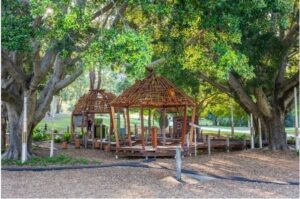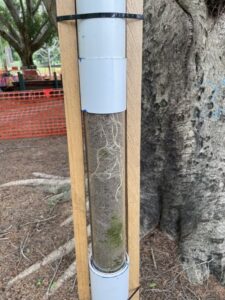
Cathedrals of roots
Training aerial roots of Ficus microcarpa at Sherwood Arboretum
By Prue McGruther
In landscape design, our attention often falls on flowers, foliage, bark, or branch structure. Roots, especially aerial, are rarely considered for their visual appeal, yet under the right conditions, figs (Ficus spp.) can form remarkable networks of aerial roots, becoming sculptural elements that are both beautiful and structurally useful.
At Brisbane’s Sherwood Arboretum, a 15-hectare riverside site and the city’s only dedicated arboretum, we are exploring how aerial root training can transform the grove of Ficus microcarpa. Established in 1925 with 72 Queensland kauri pines (Agathis robusta), the arboretum is now home to more than 1,400 native trees. In the lead-up to its centenary in 2025, several projects have combined horticultural innovation with public engagement.
One of the most significant has been the creation of a nature-inspired playground, completed in late 2024. Nestled among mature figs, the design sits lightly on the landscape. Elevated boardwalks protect surface roots and maintain airflow, while three pod-like play structures echo natural forms. The timber of the pods came from trees lost during the 2022 floods, then milled and reused onsite to reduce waste and preserve a tangible link to the site’s history.

The playground’s location provided the perfect opportunity to begin aerial root training, to both soften the presence of the built structures and to encourage natural root development as part of the play experience. This approach draws inspiration from similar work at New Farm Park in Brisbane’s inner city, where aerial roots have become part of the landscape’s charm.
Two rounds of aerial root training have been completed so far. The first targeted thicker, accessible roots close to the trunk. Each selected root was enclosed in 90mm diameter PVC pipe, supported between wooden stakes. The pipes were filled with a sand–loam mix, enriched with sphagnum moss and rooting hormone, and a funnel cone was used to add growing medium, with watering and top-ups carried out regularly. The clear PVC sections allowed staff to check the progress without disturbance.
Building on the lessons from this trial, the second round of training ran from November 2024 to May 2025, this time using a commercial landscaping potting mix, following research on Ficus rubiginosa by the University of New South Wales scientists1[GS1] . The mix was easier to source and handle, more cost-effective, and produced stronger root growth. Within just six months, several aerial roots had extended over three metres, a significant achievement given that no roots in the grove had previously reached the ground.
When the trial period ended, the base of each pipe was excavated to check for soil contact. Where contact had occurred, the pipe was removed and the root was wrapped in hessian for protection, while it adapted to open air. Over time, the hessian will degrade naturally, leaving the root fully exposed and self-supporting.
Encouraged by these results, the project has expanded to target finer aerial roots near visitor pathways and around the playground. Future plans include creating living arches between trees and trialling-controlled wounding techniques to stimulate aerial root growth in specific locations.
The impact is already noticeable. The developing roots add a sense of immersion and natural artistry to the playground and surrounding grove, inviting visitors to experience the trees in new ways. For children, the roots become part of the play environment. For adults, they provide an evolving demonstration of horticultural skill. From a practical perspective, the roots also hold the potential to reduce reliance on artificial props, by forming natural, living supports.
This work sits at the intersection of arboriculture, design, and community use. It showcases how a creative approach to tree management can enhance both plant health and visitor experience. As a horticulturist and a parent, I have seen how these spaces encourage curiosity, learning, and appreciation for the role of trees in our urban landscapes.
Sherwood Arboretum continues to grow as a living museum of native trees. Through aerial root training, we are not just caring for the health and structure of our figs – we are shaping a grove where the trees themselves become works of art, standing as living cathedrals of roots for generations to enjoy.
All images supplied by the author.
References
- Moles, A. T., Jagdish, A., Wu, Y., Gooley, S., Dalrymple, R. L., Feng, P., Auld, J., Badgery, G., Balding, M., Bell, A., Campbell, N., Clark, M., Clark, M., Crawford, K. M., de Lorenzo, O., Fletcher, A., Ford, Z., Fort, H., Gorta, S. B. Z., … Cornwell, W. K. (2020). From dangerous branches to urban banyan: Facilitating aerial root growth of Ficus rubiginosa. PLOS ONE, 15(1).
Prue McGruther
Acting Curator
Brisbane Botanic Gardens and High Profile Parks
Brisbane City Council
E: Prue.McGruther@brisbane.qld.gov.au
